
Writing for Next City, Zoe Sullivan focuses in on the function of land trusts in Puerto Rico in the after math of Hurricane Maria. Land trusts are a way to create and hold land communally for a particular purpose—in this case, to anchor the established community of Caño Martín Peña, described here as “an informal community centrally located in the Puerto Rico capital of San Juan. Eight distinct neighborhoods make up the community, clustered around a stream, a caño, that gives the area its name and identity.”
Sullivan interviews Lucy Cruz, who has lived in that community for 58 years, and the function of the land trust becomes crystal clear very quickly. “We are really proud of what we have,” says Cruz, “because to remove one person, you have to remove almost the entire community, and it’s not economically viable for the government.”
But despite the unified stance of the community, dealing with FEMA has been difficult. Cruz says that around 1,200 homes in Caño Martín Peña lost their roofs during Hurricane Maria and although by working together they have managed to rebuild 75 of them, they are stymied by FEMA’s guidelines, which require proof of individual homeownership. This problem is by no means exclusive to Caño Martín Peña, and nonprofit lawyers are still trying to solve it case by case.
Maria Hernandez, a law professor at the University of Puerto Rico, says that she and other attorneys have been deploying to help establish sworn, notarized statements that may help prove homeownership, but “in those cases, FEMA would grant assistance to some but not others,” she says. “We don’t know what criteria they used.”
Sign up for our free newsletters
Subscribe to NPQ's newsletters to have our top stories delivered directly to your inbox.
By signing up, you agree to our privacy policy and terms of use, and to receive messages from NPQ and our partners.
Caño Martín Peña became a formal community land trust since 2009 after years of trying, but their homeownership titles are collective, and this has caused those problems of “fit” with FEMA. Residents have fought for this structure before; after one attempt to revoke the Trust right after it was established, community members “organized a campaign to ensure that whoever was elected mayor of San Juan and governor of Puerto Rico in 2012 would support their right to collectively-owned property.”
Sullivan reports that in the aftermath of the storm, other communities have watched the experience of residents of the Caño Martín Peña community and are looking at the option of land trusts to protect their communities. She cites one of these efforts:
Cristina Miranda leads the board of directors for the Trust for the Development of Rio Piedras, in Puerto Rico. She believes that the community land trust model could benefit many areas. Her trust focuses on the Rio Piedras area’s community and economic development. Nearly 1,500 homes in the Rio Piedras area are abandoned. The trust prioritizes recovering abandoned properties to develop affordable housing, businesses, and nonprofit organizations.
In late May, the Trust for the Development of Rio Piedras submitted comments to the Puerto Rico Department of Housing in relation to the department’s action plan for a federal community development block grant aimed at disaster recovery efforts. The comments criticized a long-standing tendency on the island to develop new, luxury buildings instead of rehabilitating existing structures. The action plan argues: “Densifying population in urban centers like Río Piedras has the multiple effects of increased use of public transit, strengthen locally owned small business and making more efficient governmental centers.”
Elsewhere in this newswire lineup is an article that looks more broadly at changes in the housing movement. Those changes reflect some of the principles underlying a land trust as a sustainable community tool, but in Puerto Rico, where one of those crisis/opportunity moments exists, it will be important to watch and learn from where these efforts go.—Marian Conway and Ruth McCambridge













